Photo

Making the Christmas dinner yesterday I just happened to glance out the kitchen window and saw this sat on the washing line. I've seen swallows and robins sat there but never a buzzard :)
5 notes
·
View notes
Photo

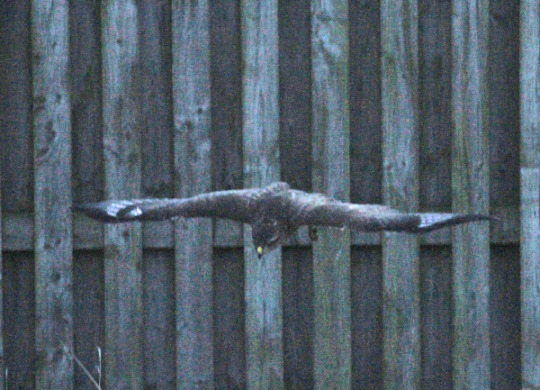
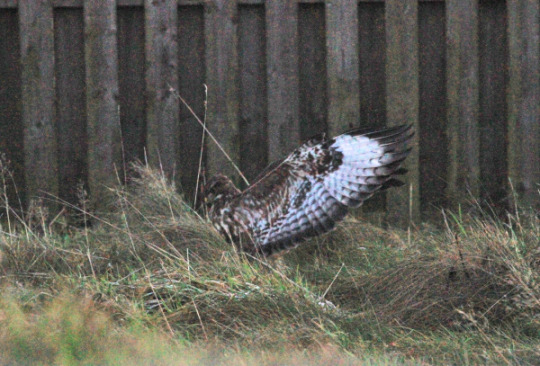
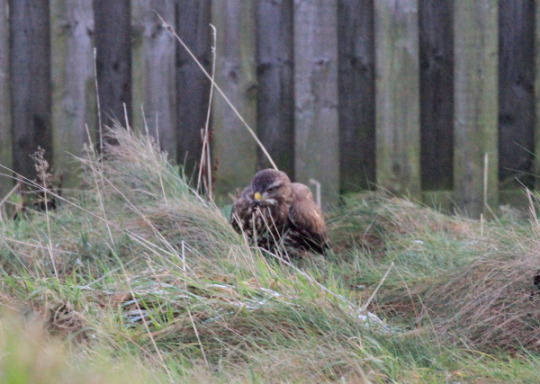
Our resident buzzard was back on its usual perch this afternoon. It sat there for a while before suddenly lurching off the fence and down into the grass. It had a tussle with something for a few seconds but emerged without a meal. Better luck next time!
3 notes
·
View notes
Text
First crossbill I've seen in the Lomond Hills
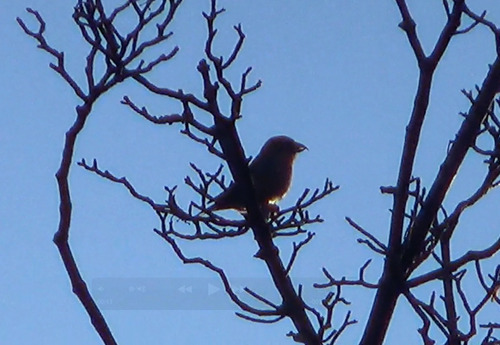
I was walking up Bishop Hill yesterday when I heard a peculiar bird song I’d not heard before. It took a wee while to locate the culprit but there was a lone bird sat at the top of a tall tree, just next to the dense conifer plantations on the south side of Bishop Hill.
It’s a bit of a ropey image, as I grabbed a still from my video camera, but hopefully you’ll be able to see the peculiar beak on this bird. It’s a crossbill, and is in fact the very first one I’ve seen in the Lomond Hills. That’s not to say that they are rare, more that they are elusive.
There are three species in the UK. The crossbill, the parrot crossbill and the Scottish crossbill. They use their irregularly shapen beaks to prise apart the tightly-packed seeds on pine / fir cones. The Scottish crossbill is endemic to Scotland, meaning it is found nowhere else in the world, but it tends to be restricted to the pine forests and plantations farther north.
This one is, I imagine, a common crossbill……but I’m certainly no expert in the matter, not least because I very rarely see these peculiar wee birds.
0 notes
Text
Hurrah! My first Fife red squirrels in over a year!

Last week, as part of the Black & White Challenge, I posted a photo of a silhouetted red squirrel that I saw a year ago on the Falkland Estate.
I got some great responses from people reporting red squirrel sightings around Fife, including one who said she'd seen reds down in Falkland. But not just anywhere in Falkland, specifically in the very part of the forest where the brass rubbings trail was installed. The very part of the forest where red sightings had been few and far between since the devastating storms of January 2012.
A few days later the same person commented on the blog a second time, saying she had again seen red squirrels that morning. I was excited at this great news, because the surveys we'd done over the previous 18 months hadn't given us much hope for reds on the estate. And because, personally, I'd not seen a red squirrel in Fife for at least a year.
Buoyed by the reliable sightings I decided to head down to the estate as soon as my next day off work came around. As I started off from the car park I bumped into the estate ranger, who said it was now more normal than not to see reds on a daily basis. Ten minutes later, as I passed the byre, I chatted to a local carpenter who said he'd seen a red squirrel outside the byre just a few weeks ago. This was huge news, because I remember him telling me last year that he'd not seen any red squirrels in five or six years. He only got greys around his house now.
I resumed my march up to the forest with a sense of anticipation, convinced I was going to see something. And to my great delight, not five minutes after entering the forest at Westfield, I heard the unmistakable sound of claws on bark.
A lone red squirrel was running up a nearby tree, and it paused just long enough for me to snap this photo:
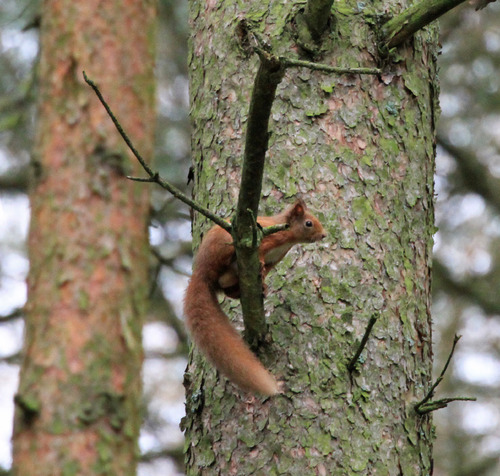
In a flash of red, it was gone. I caught one more glimpse of it as it leapt from one tree to the next, high up in the canopy.
I spent the next half hour walking slowly through the forest, off trail, looking for tell tale gnawed pine seeds and husks scattered on the floor. There wasn't much to see, but there was a simple pleasure in just wandering the forest, listening and watching.
When you actually slow down and consciously put your senses on high alert, it's remarkable what you can see and hear. The faint, barely audible chattering of near-invisible treecreepers as they flit from one tree to another:

And if you stand still for a few minutes in the forest, you realise that the whole place is awash with goldcrests. It's quite wonderful.
I continued listening out for squirrels in the canopy, and found what I think might be a squirrel drey. They tend to make them in the 'V' of two branches, or a branch and the trunk. This one looked hopeful but there was no sign of life:

After an hour strolling about the forest I headed back to the sawmill at Chancefield and again heard gnawing in the tree tops. I stepped off the path and looked about the forest floor.
Seeds and cone husks littered the ground. It was one big dirty dinner plate:

In between the sound of sawing from the mill I could still hear gnawing, plus the sound of seeds falling through branches to the ground.
Looking up I could see a steady stream of seeds falling from a tall spruce like confetti. I quietly manoeuvered myself between the trees and brittle branches until I was standing in the seed waterfall. I looked up in search of the culprit. I could see the occasional flash of a red tail high up in the top of the tree, but other than that all I could discern was the urgent gnawing of pine cones.
I leaned on a tree and waited, hoping the squirrel might head down the trunk when it was done with the spruce cones. At that moment there was a clattering in the branches and before I could even look up, something hit me on the head:

This was a squirrel with a big appetite.
After about 15 minutes the squirrel moved away through the tree tops and out of sight, but more gnawing nearby caught my attention. I could see the silhouette of a squirrel, in the top of the tree, pulling at a cone on an outer branch.
Having grabbed it, it went and sat in a more comfortable location and started gnawing. The confetti fell around me.
Peering through the branches with my zoom lens I managed to snatch a glimpse. A grey squirrel:
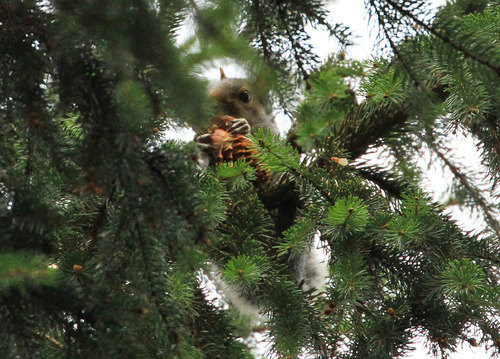
I was quite surprised. Though I know that greys and reds both inhabit the forest at Falkland, until now I'd never seen them at the same time. And certainly not sharing the same food supply in adjacent trees.
I started to wonder if I'd misidentified the red squirrel 15 minutes earlier, as this one was so clearly grey. I walked away a bit and searched the tree tops for other signs of movement. There were at least two more squirrels in the vicinity and, after a bit of patience and repositioning I got a clear view of both squirrels moving through the trees.
They were most definitely red, and didn't seem bothered about the grey next door. They were all busy getting on with feeding. And who could blame them? Stepping back for a clear shot of the canopy, I could make out a huge number of striking orange cones at the tops of the trees. Enough food for all.
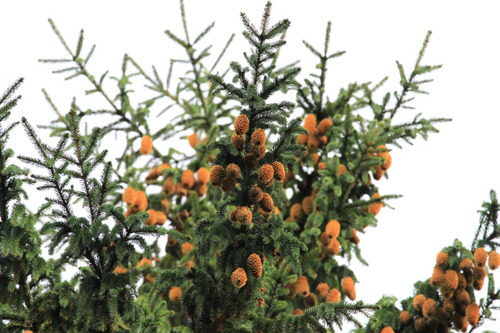
As ever when you think the perfect clear photograph might be within your grasp, it was difficult to tear myself away. And, as ever, it was my stomach that wrenched me away as it was craving lunch.
I didn't mind leaving, though. I'd found more than I'd hoped and had had a lovely couple of hours in the forest. It was lovely to see red squirrels doing so well here in Falkland.
2 notes
·
View notes
Photo

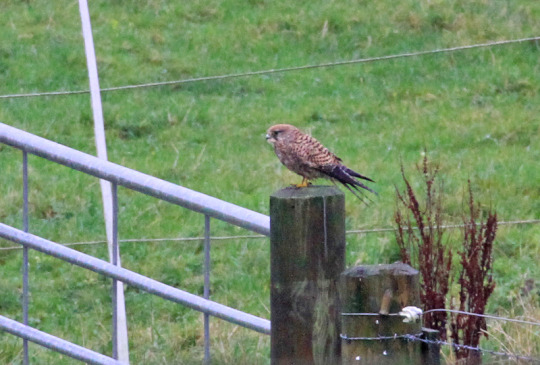
It's amazing the things you can see from your kitchen window.
I just happened to be looking in the right direction at the right time earlier today, and saw a buzzard through the fog. Perched on the fence it looked a tad wet after the soaking rain.
An hour or so later I noticed a kestrel perched on a fence post. It's been a good morning!
2 notes
·
View notes
Text
Fantastic fungi I've found
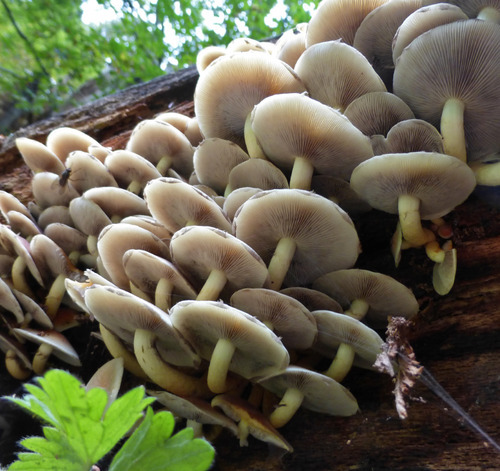
Over the course of the last few months I've been quietly snapping away at the various fungi I've encountered in West Lothian and the Lomond Hills of Fife.
I'll readily admit now that I'm not a fungi person by any stretch of the imagination. I do find them utterly fascinating and will snap hundreds of photos of them, but I find identifying them difficult.
This isn't surprising, for there are believed to be around 12,000 known species of fungi in Scotland. And identifying them can be even more problematic because the ones that we can see above ground change appearance at different stages of their lives.
I had originally intended to post them on my blog one by one, but because there are so many of the things, and given these intriguing organisms are often either overlooked or under-appreciated by the world at large, I thought I'd save them up for a collective post.
By clumping them altogether in random fashion I hope you might get a sense of just how varied, interesting and beautiful a corner of the natural world fungi are. Extraordinarily varied, in fact. And by no means restricted to the mushroom-shaped ones we're so familiar with.
Many are so distinctive that they cannot be mistaken for anything else. The fly agaric, for example.
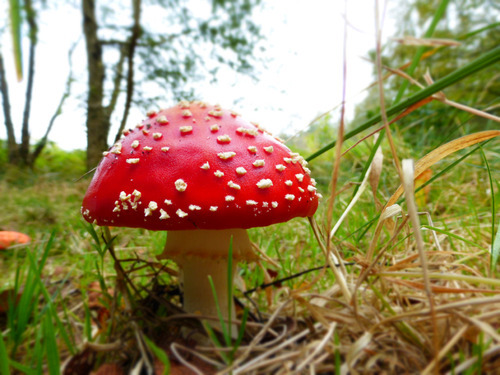
Its fairytale red and white toadstool is iconic. The stinkhorn, too. Sure to prompt sniggers at its phallic appearance and make people's faces scrunch up at its smell. Unmistakable. And yellow brain fungus. Not many fungi look like it, and more often than not I see it on gorse. A perfect example of a habitat helping you to identify something.
So forgive me for just leaving most of the following photos blank, without descriptions. I wish I knew what they were so that I could tell you, but the world of fungi is huge and intimidating, and at the moment is beyond me.
All I hope is that perhaps you go away with a new or renewed fascination of these wonderful organisms, and that you'll maybe notice and appreciate them when you're out & about.
So let's start off with the ones I know....or at least the ones I *think* I know.
Perhaps THE most distinctive fungus of all. The Fly Agaric, impossible to mistake for any other fungus.....and oh so very pretty:
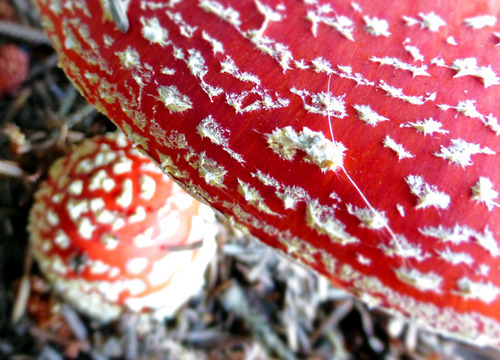
Birch polypore:
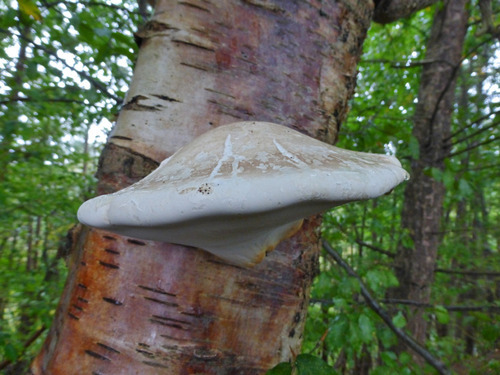
I think this might be sulphur tuft?


A puffball mushroom. And there are many different species of these:
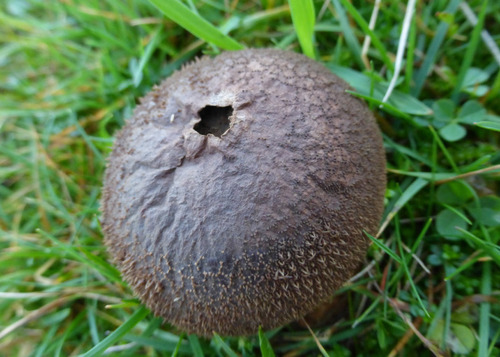
The hole at the top forms later and transforms the entire mushroom into a bellows. When it gets knocked by animals or the rain, very fine spores are ejected through the hole in a fine mist. Quite exquisite really.
Another puffball, but because of the different colour I'm assuming it therefore a different species. More likely than not, the common puffball.

Handily, the puffballs highlight the aforementioned difficulty in identifying fungi. In their early stages they can be a clean white colour with peculiar warts.

These fall off before the fungi surface adopts a strange papery texture.

One of the waxcaps, perhaps scarlet hood. Weirdly waxy to the touch:
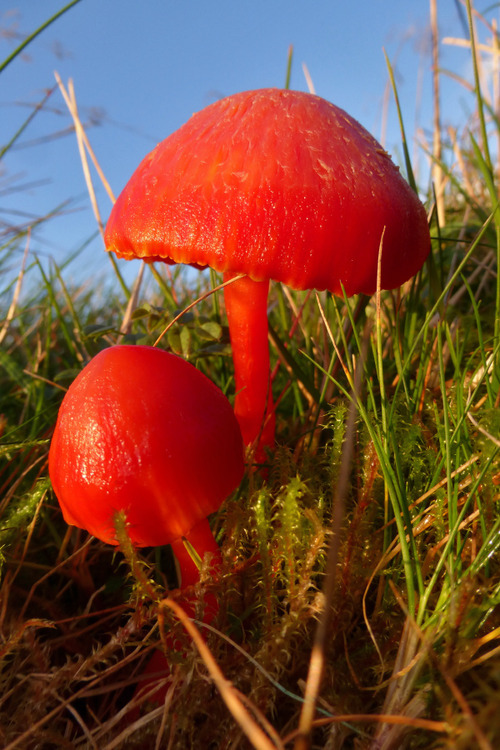
As the cap opens up the edges fade:

A shot of the gills on its underside:
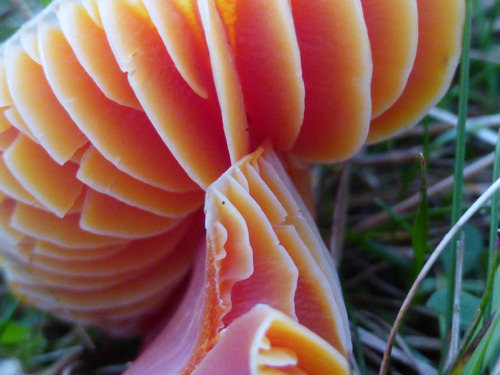
A tiny club fungus on East Lomond:

This is the first year I've seen it up there, or indeed the first year that I've noticed it. There are many types of club fungus and I'm not sure whether this is Yellow or Apricot Club Fungus. Whatever, it's rather lovely.
Moving on to another yellow one. The Yellow Brain fungus. A superb name if ever I heard one. I've only ever seen it growing on gorse here in the Lomond Hills:

Erm.....a stinkhorn. And believe me it does stink:

Some fungi can't be seen, although the effects of them can. These aren't birds' nests, they're 'Witches' Broom'. An abnormally dense growth of twigs, caused by a fungus in the branches. It makes for great silhouettes this time of year:

I found this beauty on a rotting log in the garden:

And now, I'm afraid, we're onto the legions of fungi I can't yet identify. Just skim through them and marvel at the wonderful variety. That's what I do ;-)
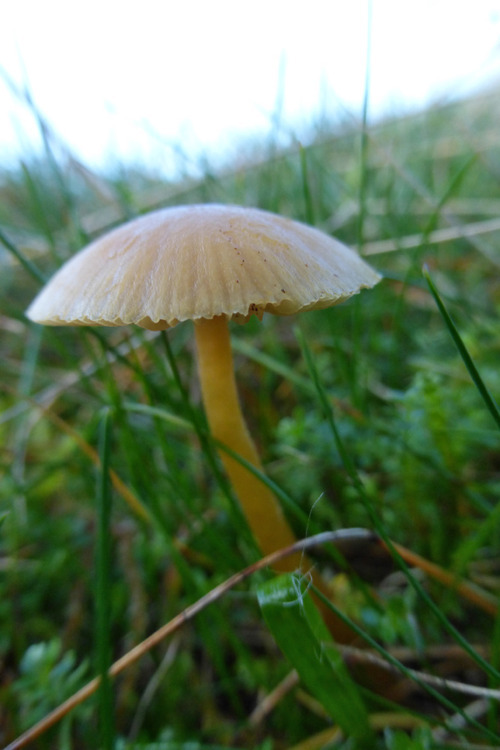


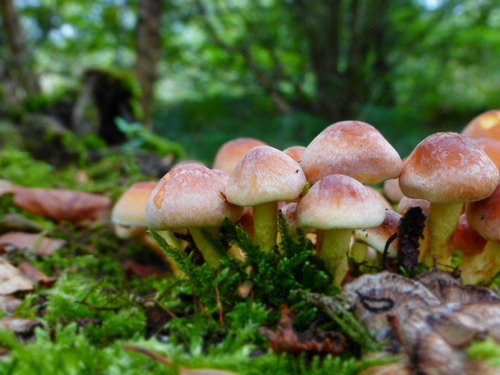


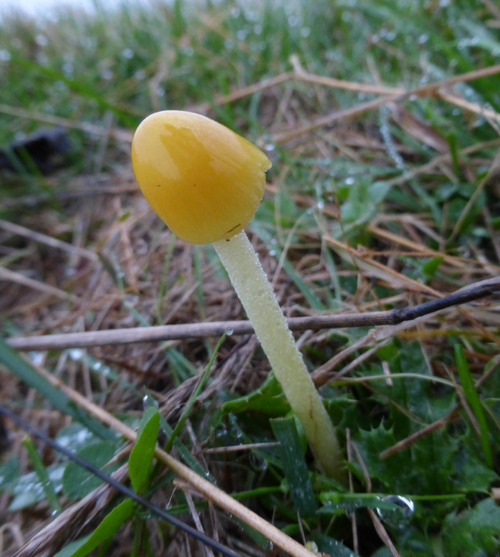


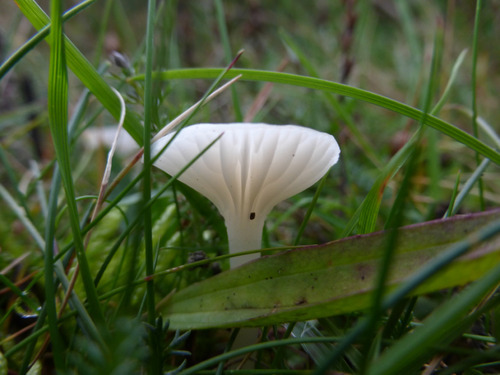





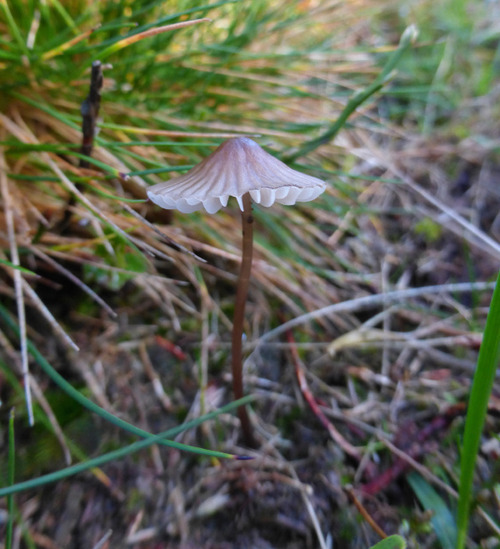

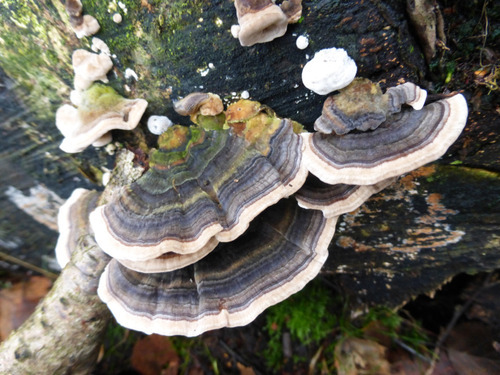
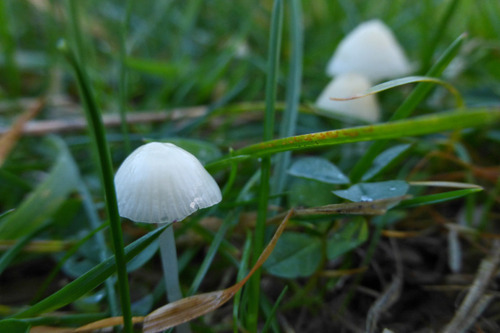
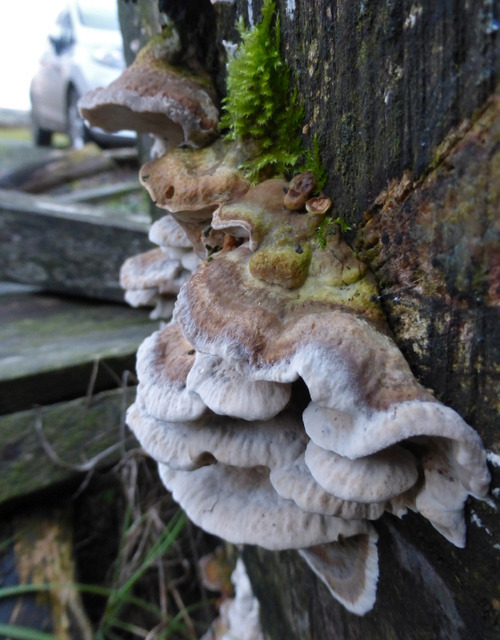




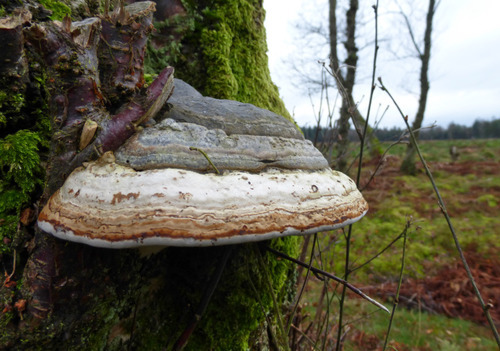
Fantastic, eh?
#fungi#Fife#West Lothian#yellow brain fungus#fly agaric#stinkhorn#witches' broom#sulphur tuft#scarlet hood#club fungus#birch polypore#puffball
84 notes
·
View notes
Text
2014 Local Patch review for BBC Wildlife Magazine
Nearly a year after the Local Patch Reporter project was launched by BBC Wildlife Magazine, all the different bloggers have been contacted by the mag to reflect upon their experience. Here are my answers to the questions they posed:
What was your wildlife highlight on your blog for 2014?
The Isle of May. In all the years I've lived in Fife I'd never visited it. Photographing puffins so close was unforgettable.
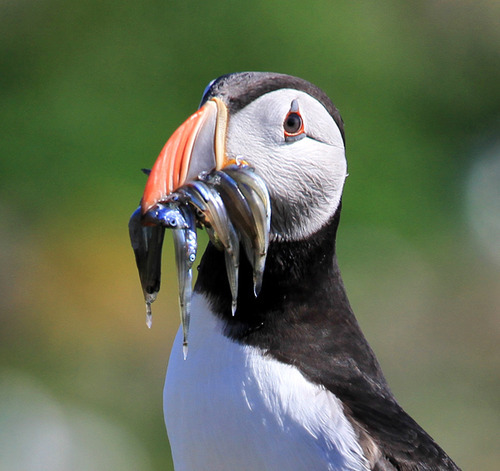
It reinforced my belief that Fife's wildlife is every bit the equal of anything overseas. Life & death struggles are played out under my nose every day.
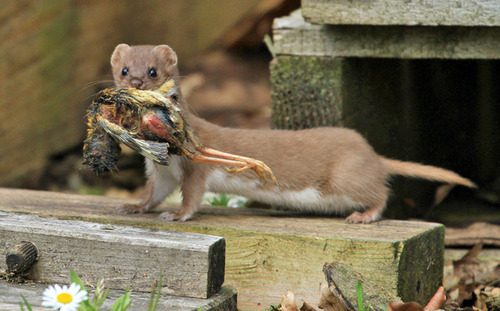
What was the biggest wildlife surprise as a blogger over the last 12 months? (A new species? Something you didn’t expect to see locally? Etc)
The mystery of the black & white deer. There were local eyewitness accounts of animals that had white rear halves, so I went out to find them. And I did!
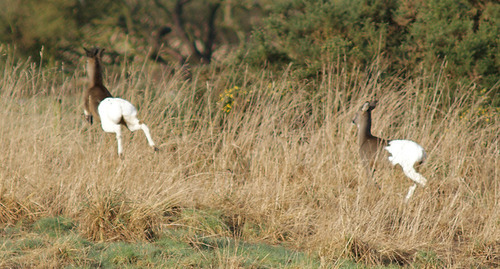
What has been the best thing about becoming a Local Patch Reporter?
Having the opportunity to promote Fife. It's talked down so often but it has so much to offer.
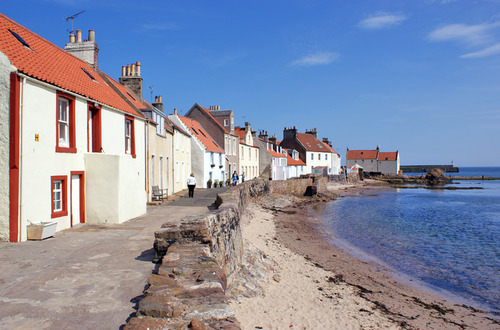
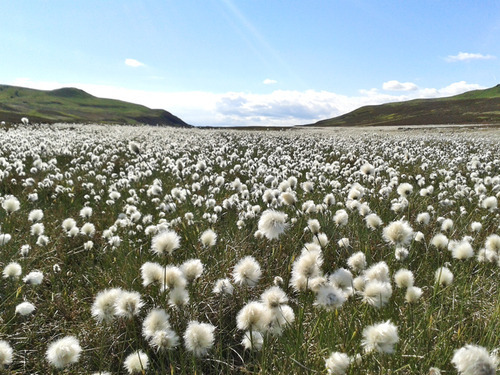


Anything else you want to share with BBC Wildlife Readers?
Come and visit us in Fife!

What advice do you have for new wildlife bloggers?
Do it because you enjoy it. It shouldn't be a chore.

Are you going to continue blogging and if so, what’s your ambition as a wildlife blogger in 2015?
I've been blogging for nearly five years now, so yep absolutely! In 2015 I'd like to get back to Skye to see more eagles and cetaceans.
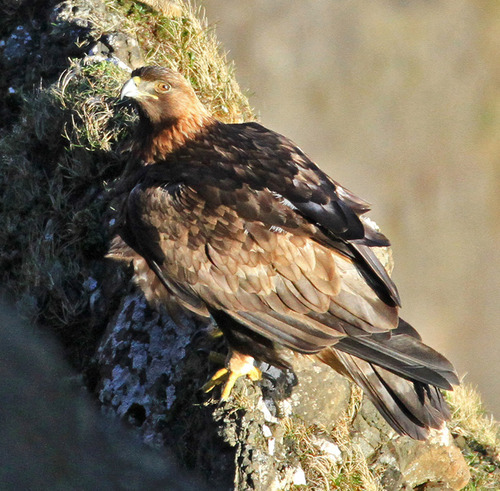
#BBC#BBC Wildlife Magazine#puffin#roe deer#weasel#Fife#Lomond Hills#Pittenweem#golden eagle#birds#mammals
3 notes
·
View notes
Text
Highlight of 2014: The Isle of May National Nature Reserve
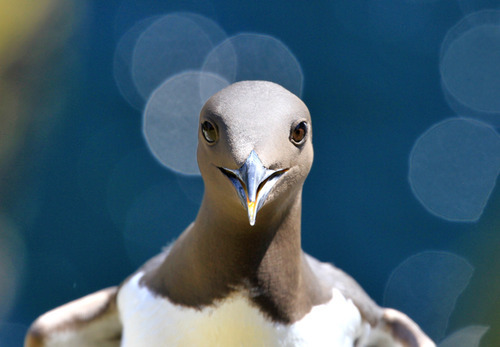
Well, it's now November. For a winter-loving weather nut like me that means just one thing. Winter is coming! Or at least it should be. Frankly it's hard to imagine it will ever arrive given the insanely mild weather of late.
But with the trees here in Fife now bare, and the summer birds long since flown south, I find myself looking back on what has been a mild, calm and sunny summer. Or at least milder, calmer and sunnier than most recent years.
Not that summer ranks highly in my list of favourite seasons, mind. My preferences are firmly rooted in the snow, ice and low winter light camp. But as a nature enthusiast I do of course recognise the pivotal role summer plays in the natural world and, how without it there would be little or no nature for me to enjoy.
It’s a Special Protection Area (SPA) for its seabird population and is a Special Area of Conservation (SAC) for its reef habitats and seal population.
On top of that, as long ago as 1956 it became one of 50 National Nature Reserves (NNR) in Scotland. And to top it all off it’s a Site of Special Scientific Interest (SSSI) on account of the breeding birds, cliffs and mammals.
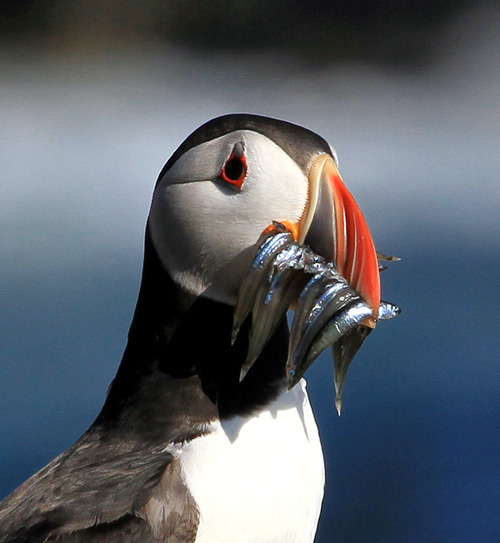
Unlike on the mainland, predatory foxes and rats are absent, which is good news for birds that nest on or under the ground. As a result, guillemots, razorbills, gulls, kittiwakes, terns, fulmars, shags, eider ducks, are all here in large numbers.
The breeding stats for the seabird colonies in 2014 aren't yet available but the island's blog had, over the summer, occasionally hinted that conditions this year have been favourable. It had been mild, calm and dry.
Happily, an island blog update on 30th September revealed it had been the most successful year on record for fulmars, and that most other species had experienced a good year too. This was welcome news in an uncertain world where sea temperatures are warming and the food these birds feed on is moving north to cooler waters.
Though the Isle of May is only a matter of miles away from where I stay in the Lomond Hills, I visited the island for the first time in June this year.
It had been a long time coming and it didn't disappoint. What I found was a greater abundance of wildlife than anywhere else I’ve been in Scotland, or indeed a great many places farther afield. That was peak time for birds of course. They have since fledged and are back out at sea for the winter.
So, here's something of a look at my all too brief highlight of 2014. A visit to the Isle of May National Nature Reserve:

A spanking new visitor centre greeted us as we disembarked, as did a noisy and irate colony of common terms nesting alongside the jetty.
Puffins were everywhere, and this was evident as soon as we stepped off the boat and moved towards the cliffs. They were sat on rocks, next to burrows, on buildings:

I was delighted, as this was the first time I'd seen puffins close up. The first thing I wanted to do, however, was get my bearings and get a sense of the place. What better way to do that than a stroll along its length?
We walked the length of the island, such as it is. At only 1800m and only a few hundred metres wide it doesn't take long to get anywhere. This is the northern end, looking to the peninsula of Rona, which was off bounds:
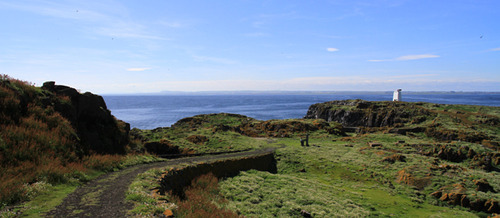
The vegetation was a lush green from the mind-blowing volumes of bird droppings that must cake the landscape. All around us, seabirds were coming and going, wheeling above us in the air, or strutting about in front of their burrows:
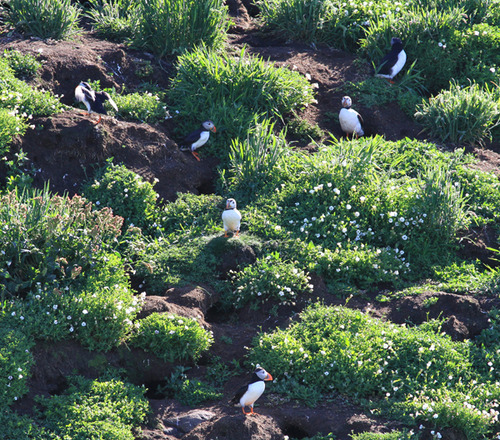
The island is of course famous for its puffins. They've have been studied for over 40 years on the Isle of May, with a census conducted every five years. Puffins burrows were at a staggering 68,000 in 2002 but have fallen back to just under 50,000 now and there was a 30% decline between 2003 and 2009.
Hardy as these tiny wee things are, they do have limits of course. A ‘wreck’ (the word for when large numbers of seabirds die in a single incident) occurred in March 2013 during the cold Spring, which was dominated by easterly winds that are believed to have made it difficult for the birds to feed. Thousands of puffins died of starvation and were washed up on the east coast.
This happened against the background of a gradual recovery which may have absorbed the wreck. This year the average number of chicks raised by each pair of puffins was apparently slightly below the average, but thankfully there doesn't appear to have been a marked decrease in numbers. Hopefully these beautiful wee birds will bounce back in the coming years.
I don't mind admitting that the bulk of my two hours on the island was spent gawping at puffins. After all, this was the first time I'd seen them close up and I was determined to make the best of the opportunity. Not least because I'd got a new SLR a few months previously and this was its first real test in the field.
Various puffins at various locations modeled for me in surprisingly willing fashion. And such was the profusion of puffins in the air that every time I snapped a pic of one sat on the rocks, there would be a blurred one whizzing past in the background:

Coming in to land...


While everyone wants to get the famous shot of a puffin with sandeels in its beak:

....it's easy to forget that they'll take other larger fish too:

After a while I managed to pull myself away from the puffins and turn my attentions to the other gems the island has to offer. Scores of gulls:

But it's only when you peer over the substantial cliffs that you realise just what a 'bird city' this rock in the Forth really is. The cliff faces are white with birds:

And on the cliff faces themselves, there were an incredible number of seabirds perched in the most improbable of places.

Kittiwakes on beautifully constructed nests, attached to sheer cliff faces:

Guillemots.....


And I managed to catch this guillemot apparently telling his doubting pals he'd caught a fish 'THIS BIG!':
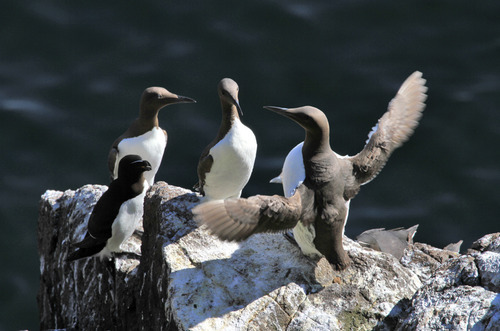
Razorbills:
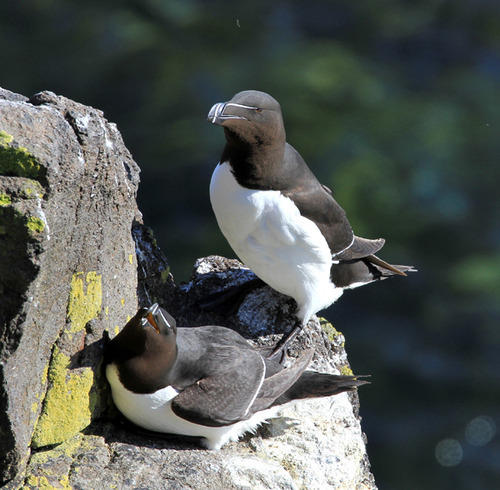
I sat peering over the edge for 20 minutes or so, watching the endless to-ing and fro-ing of birds returning from or heading out on fishing trips. It was so frenetic and chaotic that I didn't know where to look.
Sadly, no sooner had I settled down in a nice sunny spot with a grandstand view of the action, it was pretty much time to go.
We headed back down to the jetty, and as we did so we were urged to keep moving by the wardens so as not to drive the terns from their nests for too long. As we approached the boat, angry terns dive-bombed the hapless visitors all the way.

Not ten minutes later we were speeding out to sea. The grand lighthouse silhouetted on the horizon:
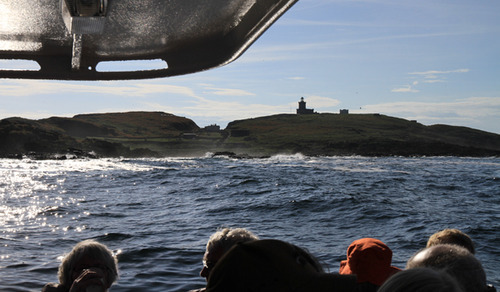
As we departed and headed back to Fife, we sailed close to the cliffs we'd sat above not an hour earlier. The sea was sheltered on this side and we got superb views of the bird-clad rocks as we passed by:


As we cleared the island, the throttle went up and we motored away. Birds continued to appear from every direction above and around us as the Isle of May steadily got smaller on the horizon.
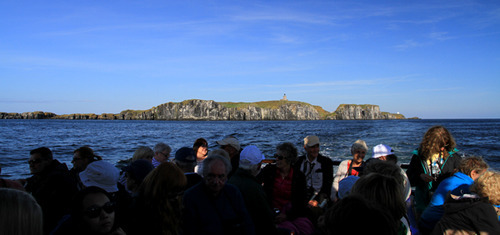
What an unforgettable experience it had been. I was staggered that I'd never been here before and I decided I had to come back next year. After all, it was just down the road from where I live!
Looking around at the faces on the boat, on what was the sunniest and calmest day of the summer so far, everyone was smiling.
And so was I :)
Related stories
I wrote a piece for Walkhighlands after my visit to the island, focusing on my lifelong goal of seeing puffins close up: In search of the perfect puffin.
3 notes
·
View notes
Text
Summer flowers still clinging on
October was mild. Again. Similar to last year in fact, with the average temperature up here in the Lomond Hills coming out at 9.3C.
That's easily warm enough for plant growth and, coupled with only one half-hearted frost so far, has meant wildflowers are stubbornly hanging on.
Red Campion is still quite conspicuous here and there, both in the upland areas and lower down:
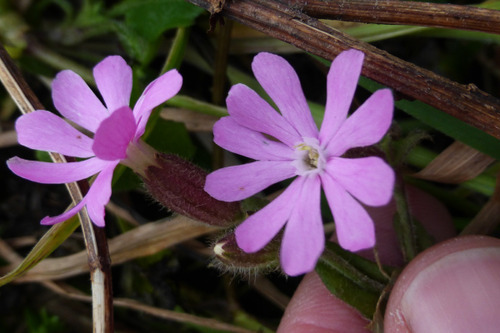
Mayweed was gone in September last year, but this year it's made it all the way to November!
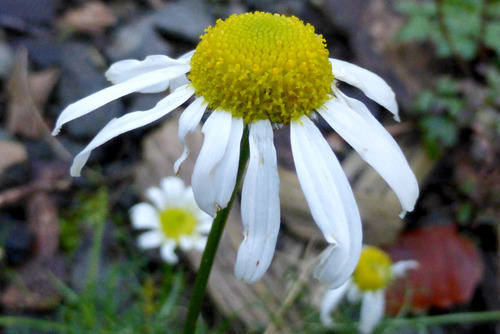
Even the oxeye daisies are clinging on in one or two spots.

And of course, herb robert. A hardy wee plant, granted, so it's used to the low temperatures. It's a mainstay of the wildflowers around the house outwith winter but at this rate I wouldn't be surprised if there were flowers out come December!

Down at Loch Leven yesterday afternoon I spotted a few gorse flowers blooming. I say spotted as though I had to look for them, but in reality they broadcast themselves clear as day when most colour in the natural world is draining out of the landscape this time of year.
The gorse flowers have long since vacated the Lomond Hills, and while it's certainly not unusual for gorse to flower all year round at lower elevations, it still adds to the general impression of things doing quite well in what is typically a lean month.

Okay, so they mightn't be the healthiest specimens you've ever seen but it does show just how peculiar this year is up here in the hills. Things might be about to change though, given the cooler weather we're experiencing now.
There has also been a greater profusion of fungi too, but more on that shortly....
#oxeye daisy#ragwort#herb robert#wildflowers#gorse#trees & shrubs#Loch Leven#Lomond Hills#Fife#loch#farmland
1 note
·
View note
Photo

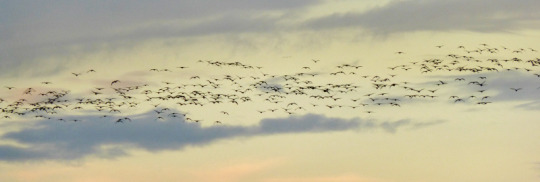


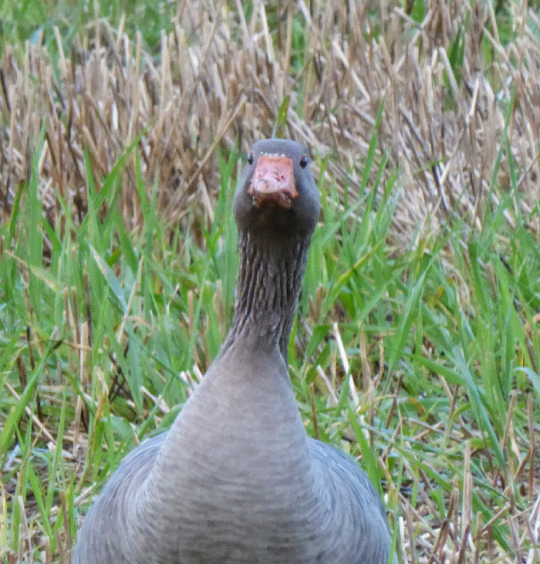
Another visitor to these shores in autumn and winter, and one that makes itself known very loudly indeed....is of course the pink footed goose.
Up to 20,000 arrive from their breeding grounds in Svalbard, Iceland and Greenland, congregating at Loch Leven in the late autumn months. Many of those then disperse elsewhere in the UK, but some will spend the winter here in Kinross-shire.
The count as of 17th October was 13285, which is some way short of the same time the previous year which was 23270. I did hear someone mention there were more pinkies than usual up at Loch of Strathbeg in Aberdeenshire, so perhaps that has something to do with it?
The geese spend the day flocking and grazing in farmers' fields, which is where I encountered this ones today at Loch Leven. I was on my bike, cycling around the 12 mile heritage trail. They were remarkably tame.
1 note
·
View note
Photo
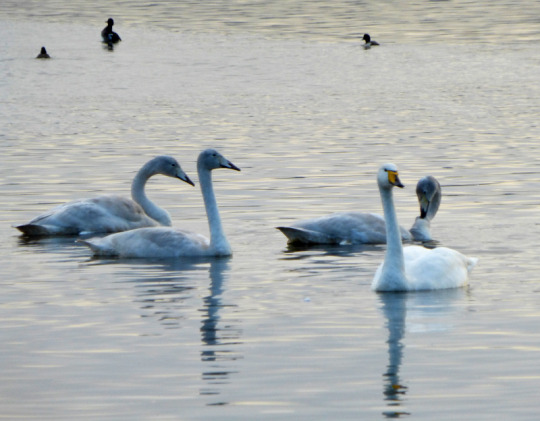
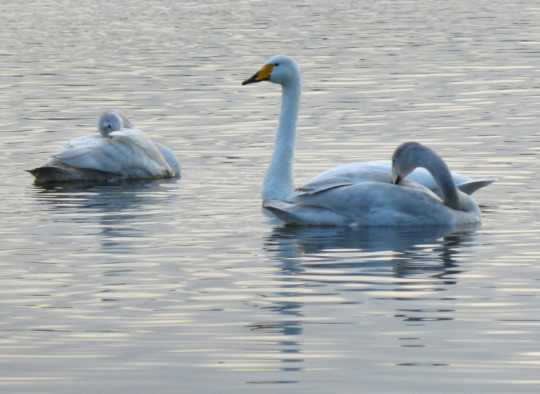
Plenty of whooper swans down at Burleigh Sands today, gentling honking away just off the shore.
Whoopers have a yellow beak, rather than the vivid orange of our familiar mute swan. And they tend to hold their necks upright rather than in the curved fashion of the mutes.
It's funny standing there at the shore, watching these birds when you know where they've come from. Most of our whoopers migrate here from Iceland, which admittedly isn't the furthest of migrations but it's still a significant amount of open ocean to cross in less than ideal weather.
Anyway, lovely to see them, especially when they have juveniles with them. The young 'uns look like black & white versions of the adults.
3 notes
·
View notes
Text
Ring ouzel and snow bunting on West Lomond

With the temperature a chilly 7C here in the Lomond Hills today, and with an exfoliating wind, I decided to head on up West Lomond (pictured above) for what can only be described as a 'bracing' walk. The sun was out, so it seemed like a good idea.
And indeed it was! Because not only did I have a super sunny amble over pathless hills, I also saw two rarities in these parts.
No sooner had I hauled myself up onto the 522m summit of West Lomond, I saw a snow bunting flitting between the ancient cairns. Clear as day, flashing its white wings as it darted about with impressive agility in what was a steady gale force wind.
It took a bit of stalking and creeping on my part, as it appeared and disappeared at various locations on the summit plateau, but I eventually managed to snap a piccie:


This was the first I'd seen over here on West Lomond, so I was a happy chappy after that. Plus it seemed to be timed perfectly, what with the plunge in temperatures and it being the coldest day of the season so far. If ever there was a day I'd want to see a SNOW bunting, it was today.
After only ten minutes on the frigid summit I went meandering down the south of the hill to spend some time at the Devil's Burdens, a strange Easter Island type rock formation:

The peculiar weathered rocks offer protection and shelter regardless of wind direction, so it's always a nice spot to sit and feel the warmth of the sun.
No sooner had I sat down, I saw something large and black whizzing between the rocks. My first thought was a ring ouzel but I've NEVER seen one in the Lomond Hills so thought it was probably a crow or some other corvid.
I thought no more of it, not until 20 minutes later when I heard that distinctive clicking noise. Similar to the stonechat, ring ouzels make a noise that sounds like two pebbles being struck together. I've seen and heard enough ring ouzels in the highlands to know that noise when I hear it, so I set about following the noise to its source.
It was extremely skittish, so I didn't manage to get very close. This is the best I could manage:
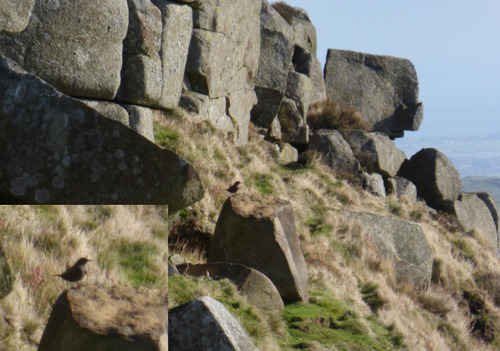
It didn't have the striking white bib so was probably a female. I did wonder if I'd seen a stonechat for a moment, but they sit much more upright than this, and are smaller. This was much bigger than a stonechat and had a long tail in flight.
It does seem strange to see one here, in the uplands, as late as mid-October. But then again, it has been mild. All in all I'm 99% certain it's a ring ouzel, and obviously the fact I've never seen one in these parts is what's accounting for the 1% uncertainty ;-)
1 note
·
View note
Photo

10 minutes ago a blog post called 'where have all the kestrels gone?" appeared in my Twitter feed. It was written by a chap who noticed how he'd recently driven 2370 miles across England and had seen only five kestrels.
They are in decline in many areas, so I'm happy to report that this one (pictured) was sat on an aerial next door not one hour ago.
0 notes
Photo


I had another pedal around Loch Leven's 12 mile trail today, and was treated to a big Loch Leven lift-off of pink-footed geese.
These pics show the 'before and after' as the strange, charcoal-like line of geese on the water suddenly filled the sky. After a few minutes they settled in a field just outside Milnathort.
If you've never seen and heard a sky full of honking geese, you haven't lived ;-)
0 notes
Photo
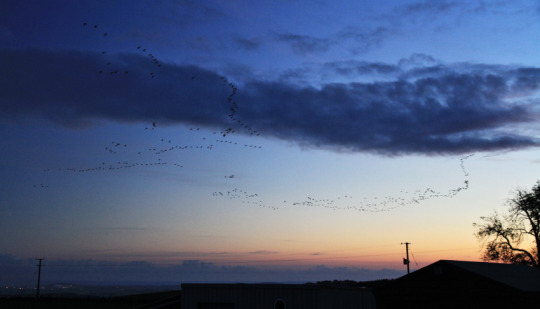
A big flock of pink-footed geese over the house a moment ago. Big.....but not REALLY big. Hopefully as October wears on we'll see some of the much larger gatherings of previous years.
0 notes
Text
Autumn is here and the Lomond Hills are buzzing!

Well, there's no mistaking that autumn has arrived. After a unseasonably mild and dry September, autumn stormed its way into the start of October......quite literally.
Early yesterday morning I didn't really get much sleep what with the roaring wind and lashing rain on the window. A chilly 7C with sustained 35mph winds and a wintry wind chill left us in no doubt summer has finally left these shores.
The summer visitors have long since departed, however. I've not seen a swallow for a couple of weeks, the curlews disappeared weeks ago and the skylarks are nowhere to be seen.
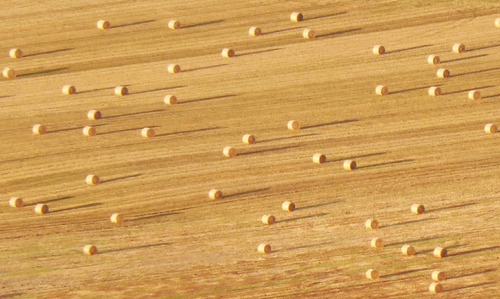
Clouds of insects bobbing up and down in the calm after the storm:

Although it's been colder of late with temperatures down to 4C, we've not had a frost so it's not surprising there are still so many insects around. That might explain why the stonechats are still here. Usually they disappear from this part of the Lomonds in September, presumably for milder locations down the hill or by the coast. I heard a few of them clicking as I walked the paths, and this female was flitting between the spent rosebay willowherb:

Despite the mild autumn thus far, some winter visitors are already here in large numbers. A mild autumn here doesn't mean its mild everywhere, and indeed the pink-footed geese began arriving from the cooling Arctic at the end of September.
They roost around Loch Leven a few miles west of here, but make daily flights out to the farmland here in Fife. Hundreds pass over on their outward journey throughout the day, before assembling and returning en masse as the light begins to fade. A few hundred passed over yesterday evening:
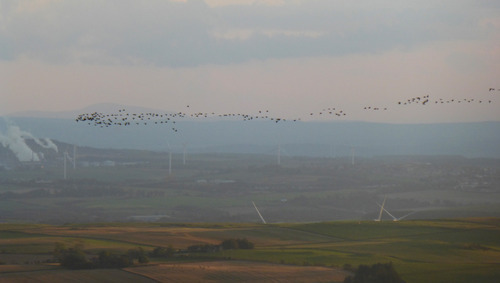
As the geese passed in the distance I caught sight of a kestrel perched at the very top of a spruce tree. They're skittish birds and will fly off before you can get close, so it was odd to be able to get so close to this one. Close by, somewhere in the heather, I could hear a young pheasant clucking away. I'd have thought a pheasant was too large for a kestrel but maybe it fancied its chances?

Walking home, as the sun set, two roe deer appeared from the gorse in front of me. One ran off but the other stood its ground and stared at me....

....before trotting up the slope for a better look. A buck with a lack of symmetry in his antlers:

Then he leapt clean over a fence and was gone. It was a nice flourish to end what was really a brief walk over my favourite wee hill. As you can see, winter may be approaching but the Lomonds are still buzzing with wildlife if you keep your eyes peeled.
Oh....we get great sunsets up here too ;-)

3 notes
·
View notes
Photo

Seems to be a good year for berries. This hawthorn at Almondell was bursting today.
4 notes
·
View notes